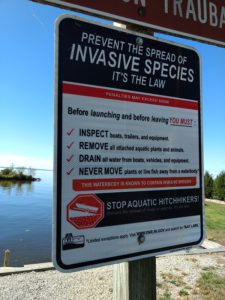Every month, we will put a spotlight on an aquatic invasive species (AIS) in a re-occurring monthly article. This month, Reed Manna Grass! Check it out!
Reed manna grass (Glyceria maxima) is a semi aquatic grass native to Europe and Asia. The first record of Glyceria in North America was in the 1940s at the west end of Lake Ontario. However, the first record of the plant in the United States was a population discovered near Milwaukee in 1979. The plant has only  been found in a few U.S. states including Wisconsin, Massachusetts, Washington, Illinois, and Michigan. Glyceria maxima is thought to have been introduced intentionally to serve as a forage species but may have also been introduced unintentionally in solid cargo ship ballast or in packing material.
been found in a few U.S. states including Wisconsin, Massachusetts, Washington, Illinois, and Michigan. Glyceria maxima is thought to have been introduced intentionally to serve as a forage species but may have also been introduced unintentionally in solid cargo ship ballast or in packing material.
Glyceria maxima is a perennial plant that grows from a rhizome, similar to Phragmites. Reed manna grass can grow up to 9 feet tall and has unbranched stems and flat leaves with a shallow groove. The most recognizable feature of reed manna grass is the inflorescence, or flowers. The inflorescence branches and have short, stiff hairs. Flowers form from June to August which produce seeds that are 0.07 inches long and can be transported by water and hitchhiking on equipment. The rhizome of the plant is the main form of plant reproduction and spread. The rhizome sends out stems horizontally and vertically that result in vegetative reproduction. As a result, Glyceria maxima forms dense stands and can quickly crowd out native species. Glyceria maxima grows best in open wetland areas and along shorelines. However, it can grow rooted in a lake up to a foot of water. There are several reports of reed manna grass forming floating mats attached to the shore.
Due to the energy stored in the rhizome, Glyceria maxima can grow earlier in the spring at a rapid rate that outcompetes native  species. Many wetland species do not use reed manna grass as a food source or for nesting sites. The root system of dense beds of Glyceria maxima can trap sediment and change water flow leading to flooding.
species. Many wetland species do not use reed manna grass as a food source or for nesting sites. The root system of dense beds of Glyceria maxima can trap sediment and change water flow leading to flooding.
Glyceria maxima is classified as a Prohibited species in a majority of the state but is restricted in Brown, Calumet, Columbia, Dane, Dodge, Door, Fond du Lac, Green, Jefferson, Kenosha, Kewaunee, Manitowoc, Milwaukee, Outagamie, Ozaukee, Racine, Rock, Sheboygan, Walworth, Washington, Waukesha and Winnebago Counties.
In the Winnebago System, Glyceria maxima was first officially recorded in 2016 near Lake Winnebago. It is verified to be in the Winnebago System watershed in Calumet and Winnebago Counties.
Want to help? HELP PREVENT THE SPREAD!
Every time you come off the water, make sure to follow these steps to stop the spread of faucet snails and other aquatic invasive species:
* Inspect boats, trailers, push poles, anchors, and other equipment for attached aquatic plants or animals.
* Remove all attached plants or animals
* Drain all water from boats, motors, livewells and other equipment
* Never move live fish away from a waterbody
* Never release aquarium plants or animals into your local waterways
Follow the Fox Wolf Watershed Alliance’s Winnebago Waterways Program on our Winnebago Waterways Facebook page or @WinnWaterways on Twitter! You can also sign-up for email updates at WinnebagoWaterways.org.
The Fox-Wolf Watershed Alliance staff continue to work to protect and restore our water resources during these difficult times. While we have transitioned to working remotely, we are still conducting meetings (remotely, of course), implementing projects, and planning for the summer. Stay safe!
Questions? Comments? Contact Chris Acy, the AIS Coordinator for the Winnebago Waterways Program covering Fond du Lac, Calumet, Outagamie, and Brown and Winnebago Counties at (920) 460-3674 or chris@fwwa.org!
Winnebago Waterways is a Fox-Wolf Watershed Alliance program. The Fox-Wolf Watershed Alliance is an independent nonprofit organization that identifies and advocates effective policies and actions that protect, restore, and sustain water resources in the Fox-Wolf River Basin.
All text from this article is from the Winnebago Waterways AIS Strategic Plan. Sources can be found in the AIS Strategic Plan document.
Photo Credit: Leslie Mehrhoff, Chris Acy
